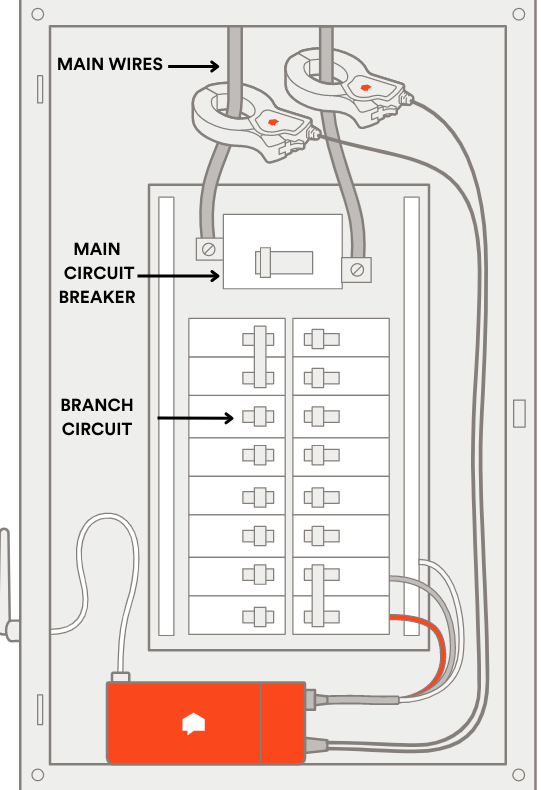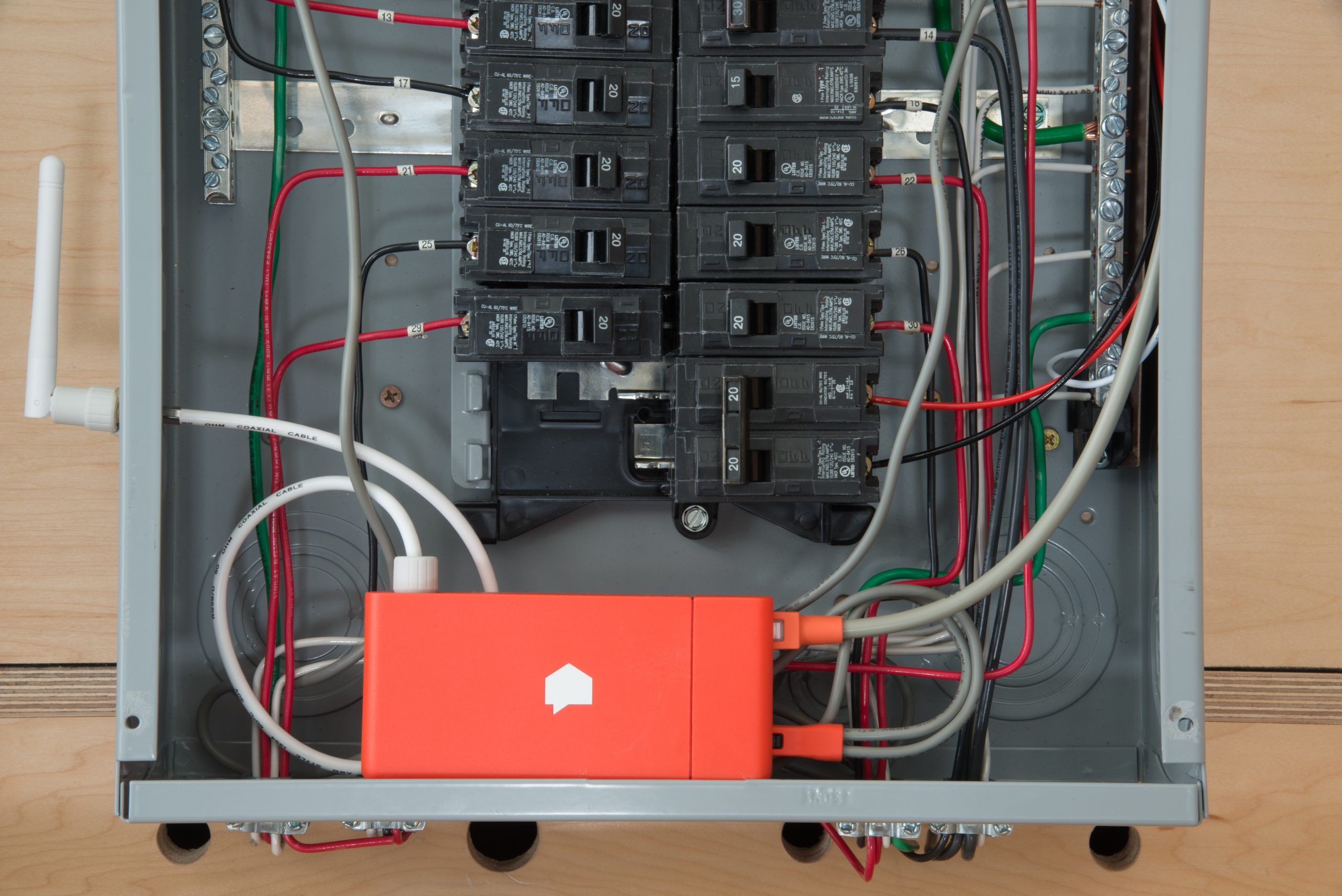The modern electrical panel is like a highway interchange for your house. It performs two important functions: it carries electricity to the outlets and fixtures in your home and it prevents overloads that could cause house fires.
The power to run your appliances typically begins at a power plant. It travels over long distances through high voltage wires–the tall towers that disturb many a homeowner’s views out their windows–through a transformer at a substation that steps down the voltage, and then through another local transformer, one of those big “cans” you may see on telephone poles along the road, where it steps down again. Finally, the electricity passes through the power lines to the meter at your home and into the breaker panel. The voltage that could be measured in the thousands at the beginning of its journey is rated at 120V or 240V at your panel—just the right amount to keep your home running.
Figure 1 shows a schematic of the typical breaker panel you will find in the basement, utility closet, or garage in most homes today. It is a gray metal box with a door. The main circuit breaker is on the top, which can shut off your home’s entire power supply. The power from your meter feeds into the main circuit breaker. Below the main circuit breaker are two vertical rows of branch circuit breakers that feed into sections of your home. Yours might be labeled “Dining Room,” “Kitchen Lights,” “Master Bedroom,” and so on. Appliances that use a lot of energy, like HVAC systems or electric stoves, may have their own breaker.

Figure 1
A panel cover protects the live mains that conduct power into the panel from the utility meter. Leave the panel cover closed at all times. Electricians are trained to work carefully around those dangerous mains when installing the Sense Home Energy monitor or making repairs to your system. The figure shows an electrical panel with the panel cover open, revealing the mains.
How Home Electricity Works
To understand home electricity, let’s start with basic terminology.
- Voltage: the electrical force that pushes electricity through a wire, measured in volts.
- Current: the flow of electrons through a wire, measured in amperes (amps).
- Power: the electrical power in a circuit equals voltage multiplied by current. The higher the voltage (the push) and the higher the current (the flow of electrons), the higher the power, which is measured in watts. 1000 watts = 1 kilowatt.
- Energy: The power an electrical device uses over time, expressed as kilowatt hours (kWh).
- Resistance: A measure of the opposition to current flow in an electrical current, measured in ohms.
Ohm’s Law describes the relationship between voltage, current, and resistance.
Voltage = Current (amps) x Resistance (ohms)
In other words, if you are “pushing” a high current through a circuit with high resistance, you need to pump the voltage. The human cardiovascular system provides a good analogy. The blood flow rate is current, the vessels and capillaries provide the resistance, and the heart provides that voltage to keep the blood flowing.
It’s helpful to know the terminology because the capacity of electrical panels is described in amps and volts, while the power draw of appliances and lights is described in watts, and your utility bills you for the power your home consumes in kilowatt hours.
How a Panel Controls Electricity
You may remember when circuits were protected by round, screw-in fuses that had to be replaced each time they were “blown.” New electrical panels have circuit breakers that don’t need to be replaced for the life of the breaker box. In older homes, the total current into the house was set at about 100 Amps, maximum. Newer homes that are bigger and have more electrical devices can require 200 Amps or more.
The electrical current divides into circuits in your house. Each circuit covers an area of the house and all the electric appliances in the area. Each breaker in the panel will trip at a different limit determined by the breaker’s amperage rating. This is also true for the main breaker. So in a 200A panel, if more that 200 amps are used across your home, it will trip the main breaker, minimizing the possibility of sparking or fire.
When a circuit breaker does its job shutting off an overloaded circuit, the breaker switch pops into the middle, between the on and off sides, which stops the current flowing through the breaker, similar to the way a light switch turns a light on or off. To reset your system–after turning off a couple of your appliances to relieve the circuit–you flip the breaker switch to the off position and back to the on position. It makes a distinctive clicking sound that most homeowners are familiar with.
If you expand your house, upgrade a major electrical appliance or buy an EV, you may need to upgrade your breaker panel to meet a high load. If your main breaker is tripping frequently, you may need to upgrade. It can cost $3,000 to $5,000 to upgrade a 100 amp capacity panel to 200 amps. Also, if your panel simply doesn’t have room for additional circuits, a licensed electrician may install a subpanel to expand it without changing the overall service level.
Once the power comes into your house and gets used by your electrical devices, the leftover electricity flows back out of the house via the mains.
Sense System Operation
The Sense Home Energy Monitor shown at the bottom of the panel in the figure gives your electrical system a Ph.D. in Electric Engineering—making it a very smart home. The Sense sensors clip around the main circuits inside the panel and read the electrical current 1 million times per second, while machine learning analyzes the patterns of devices turning on and off. The optional Sense Flex sensors can track solar power or up to two circuits of your choice, such as an HVAC system, dishwasher, or electric oven.
As you see electrical patterns in the Sense Home app, you can make practical changes to your home energy use that will save you electricity and money while minimizing the greenhouse gasses you create.
The Sense Home Energy Monitor can be installed in various panel configurations, including these:
- Split service systems up to 400A where service is provided via dual panels.
- Subpanels, provided that the monitor is installed in the main panel and the sub panels are downstream of this panel.
- Combination panels, using Sense’s re-designed slimmer sensors.
- Recessed or flush-mounted panels, using a specific installation process. Efficiency Vermont has been in the business of helping Vermonters and anyone who will listen, save energy and money and decrease emissions for over twenty years. The nonprofit points to three benefits associated with the Sense monitor. First, you can make more informed choices if you an understand how much energy each electrical devices uses and when it uses it. For example, it can make you an energy “vampire” slayer. A vampire is any device that uses standby power even when it is “off”. Devices now are losing less and less standby power, but you can still save energy and money by using “smart strips” that shut off devices completely when they are not in use, like a TV set-top box or an audio power bar. A study done in 2015 by the Natural Resources Defense Council showed that you can save as much as a quarter of your energy use by slaying your vampires. Second, you can find out which devices use the most electricity. Is it the fridge? You can decide to swap out an older model for a highly efficient Energy Star model or adjust how it functions to use less energy. Or you can find out where the lights are on when not needed and start paying attention to the off switches when you leave a room.Finally, a Sense monitor can give you peace of mind while away from home. The Sense monitor will let you know if you left the fridge door open or forgot to turn off your stove.Using Sense will make your home smarter. But even more important, it will make you and your family smarter and wiser about your energy use at home. At the very least, if you read this article, you will know much more about breaker panels than most people. It’s a start.Jim Gunshinan is a science writer who covers energy and the environment. He was the editor of No Regrets Remodeling, Second Edition, a science blogger for a PBS affiliate, and editor of a magazine covering green home building and renovation. Jim lives in Walnut Creek, California
